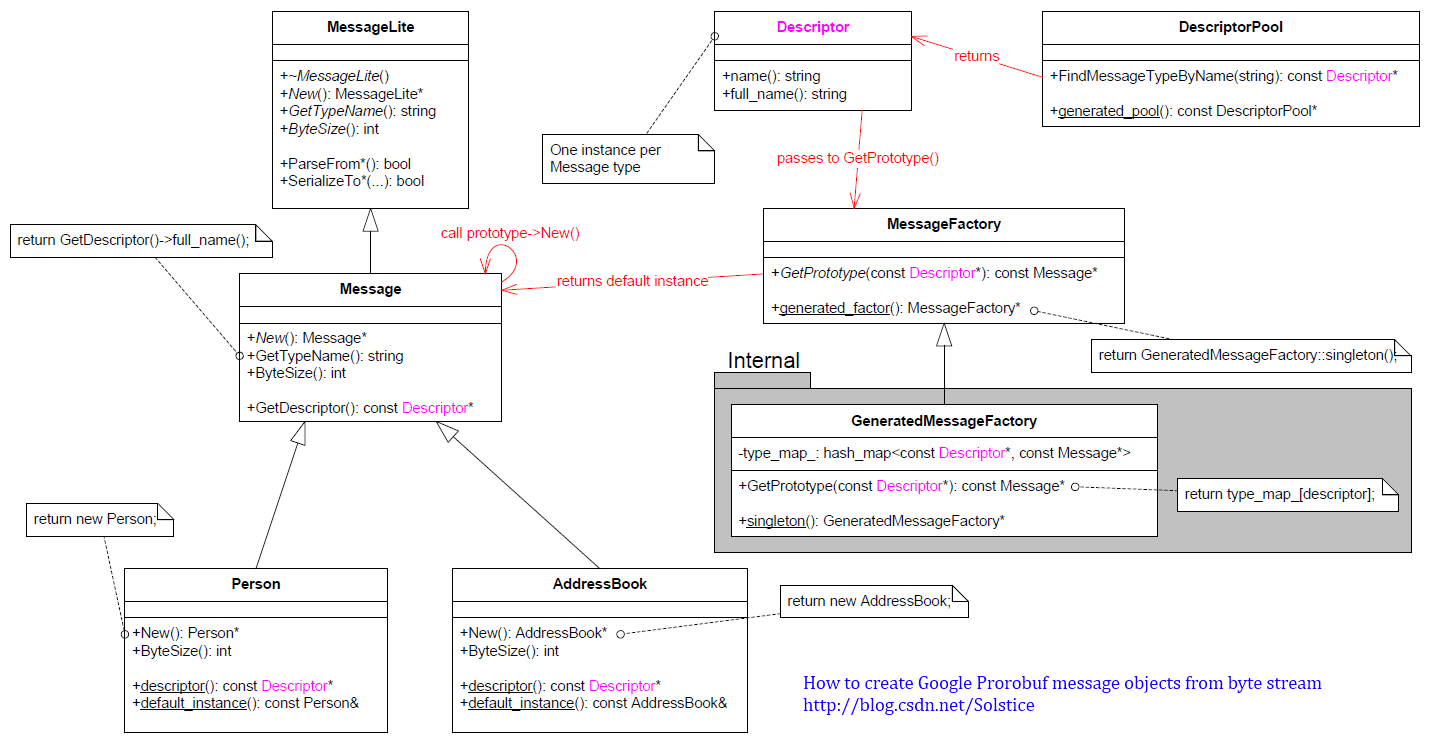解析Google Protocol Buffer消息类型的自动反射原理
Google Protocol Buffer(简称protobuf)是Google内部混合语言数据标准,protobuf是一种紧凑的可扩展的二进制消息格式,适合做网络数据传输、数据存储的消息格式。
protobuf作为网络传输的消息格式,有两个问题需要解决:
- 消息长度。protobuf打包的数据没有自带长度信息,需要应用程序自己在发送和接收消息的时候做切分。
- 消息类型。protobuf打包的数据没有自带消息类型,需要由发送方把类型信息传给接收方,接收方再根据收到的消息类型创建具体的Message对象。
第一个问题很好解决,可以在protobuf消息的前面附加一个固定长度的HeaderLen即可。
第二个问题可能很多人会想到在HeaderLen和protobuf消息之间再加上一个消息类型数据段,由接收方根据不同的类型创建相应的Message对象。但其实protobuf已经自带了消息类型反射的功能。
自动反射
Google Protocol Buffer具有reflection的功能,可以根据type name创建相应的类型的Message对象。(下图引用自陈硕的blog)
protobuf自动反射功能的关键所在就是Descriptor了,每个Message对象对应一个相应Descriptor。尽管创建Mesasge对象的过程中没有直接调用Descriptor,但是它却在其中起到了关键桥梁的作用。
|
这样使用type_name传参调用DescriptorPool的FindMessageTypeByName拿到一个const类型的Descriptor,然后再通过Descriptor的GetPrototype获得const类型的Message,最后经由const Message的New即可得到一个可自由读写的Message对象。但是需要注意的是这个对象是动态创建的,调用者在使用完毕后必须动态释放掉它,所以推荐使用shared_ptr管理该对象。
原理
知道了如何使用protobuf进行消息类型的自动反射后,下面就来讲讲它是如何实现的。
首先我们在源码中找DescriptorPool::FindMessageTypeByName的实现:const Descriptor* DescriptorPool::FindMessageTypeByName(
const string& name) const {
Symbol result = tables_->FindByNameHelper(this, name);
return (result.type == Symbol::MESSAGE) ? result.descriptor : NULL;
}
发现其中调用了tables_的FindByNameHelper函数,关于table_可以在DescriptorPool定义中找到
// This class contains a lot of hash maps with complicated types that |
table_是一个数据表项的集合(在目前手上的protobuf 2.6版本中是std::map和std::set的集合,其中的HashMap也是由std::map和std::set实现的),这样基本就可以推断出是在这个数据表项集合中通过type name查找得到相应类型的Descriptor。
这个时候就有个疑问了,这个数据表项集合中的内容是什么时候生成的?
先来看一个简单的protobuf文件,rpc.protopackage blink;
enum MessageType
{
REQUEST = 1;
RESPONSE = 2;
ERROR = 3; // not used
}
enum ErrorCode
{
NO_ERROR = 0;
WRONG_PROTO = 1;
NO_SERVICE = 2;
NO_METHOD = 3;
INVALID_REQUEST = 4;
INVALID_RESPONSE = 5;
TIMEOUT = 6;
}
message RpcMessage
{
required MessageType type = 1;
required fixed64 id = 2;
optional string service = 3;
optional string method = 4;
optional bytes request = 5;
optional bytes response = 6;
optional ErrorCode error = 7;
}
在使用protobuf编译器生成得到的rpc.pb.cc文件中可以看到这样一个函数void protobuf_AddDesc_rpc_2eproto() {
static bool already_here = false;
if (already_here) return;
already_here = true;
GOOGLE_PROTOBUF_VERIFY_VERSION;
::google::protobuf::DescriptorPool::InternalAddGeneratedFile(
"\n\trpc.proto\022\005blink\"\237\001\n\nRpcMessage\022 \n\004typ"
"e\030\001 \002(\0162\022.blink.MessageType\022\n\n\002id\030\002 \002(\006\022"
"\017\n\007service\030\003 \001(\t\022\016\n\006method\030\004 \001(\t\022\017\n\007requ"
"est\030\005 \001(\014\022\020\n\010response\030\006 \001"
"(\014\022\037\n\005error\030\007 \001"
"(\0162\020.blink.ErrorCode*3\n\013MessageType\022\013\n\007R"
"EQUEST\020\001\022\014\n\010RESPONSE\020\002\022\t\n\005ERROR\020\003*\201\001\n\tEr"
"rorCode\022\014\n\010NO_ERROR\020\000\022\017\n\013WRONG_PROTO\020\001\022\016"
"\n\nNO_SERVICE\020\002\022\r\n\tNO_METHOD\020\003\022\023\n\017INVALID"
"_REQUEST\020\004\022\024\n\020INVALID_RESPONSE\020\005\022\013\n\007TIME"
"OUT\020\006", 365);
::google::protobuf::MessageFactory::InternalRegisterGeneratedFile(
"rpc.proto", &protobuf_RegisterTypes);
RpcMessage::default_instance_ = new RpcMessage();
RpcMessage::default_instance_->InitAsDefaultInstance();
::google::protobuf::internal::OnShutdown(&protobuf_ShutdownFile_rpc_2eproto);
}
可以看到这个函数将上述.proto文件的元信息传入DescriptorPool::InternalAddGeneratedFile了。void DescriptorPool::InternalAddGeneratedFile(
const void* encoded_file_descriptor, int size) {
InitGeneratedPoolOnce();
GOOGLE_CHECK(generated_database_->Add(encoded_file_descriptor, size));
}
进而又传入了generated_database_的Add函数中去了,在源码中找到generated_database_的定义EncodedDescriptorDatabase* generated_database_ = NULL;
inline void InitGeneratedPoolOnce() {
::google::protobuf::GoogleOnceInit(&generated_pool_init_, &InitGeneratedPool);
}
static void InitGeneratedPool() {
generated_database_ = new EncodedDescriptorDatabase;
generated_pool_ = new DescriptorPool(generated_database_);
internal::OnShutdown(&DeleteGeneratedPool);
}
这样在之前InternalAddGeneratedFile中就初始化了generated_database_,接着找到generated_database_的类型EncodedDescriptorDatabase及其add的定义。class LIBPROTOBUF_EXPORT EncodedDescriptorDatabase : public DescriptorDatabase {
public:
// ...
bool Add(const void* encoded_file_descriptor, int size);
// ...
private:
SimpleDescriptorDatabase::DescriptorIndex<pair<const void*, int> > index_;
};
bool EncodedDescriptorDatabase::Add(
const void* encoded_file_descriptor, int size) {
FileDescriptorProto file;
if (file.ParseFromArray(encoded_file_descriptor, size)) {
return index_.AddFile(file, make_pair(encoded_file_descriptor, size));
} else {
GOOGLE_LOG(ERROR) << "Invalid file descriptor data passed to "
"EncodedDescriptorDatabase::Add().";
return false;
}
}
之前的.proto元数据传入了index_成员的AddFile函数中,而index_的类型DescriptorIndex<pairtemplate <typename Value>
class DescriptorIndex {
public:
// Helpers to recursively add particular descriptors and all their contents
// to the index.
bool AddFile(const FileDescriptorProto& file,
Value value);
// ...
private:
map<string, Value> by_name_;
map<string, Value> by_symbol_;
map<pair<string, int>, Value> by_extension_;
};
果然,DescriptorIndex实际上是一些数据表项集合的包装,也就是说之前的.proto元数据存入了数据表项集合中。
也就是说在protobuf生成的rpc.pb.cc文件中的protobuf_AddDesc_rpc_2eproto函数可以将.proto的元数据存入数据集合中。
接着,我们可以在rpc.pb.cc中发现下面一段代码:struct StaticDescriptorInitializer_rpc_2eproto {
StaticDescriptorInitializer_rpc_2eproto() {
protobuf_AddDesc_rpc_2eproto();
}
} static_descriptor_initializer_rpc_2eproto_;
在全局对象static_descriptor_initializer_rpc_2eproto_的构造函数中会调用protobuf_AddDesc_rpc_2eproto函数。我们知道C++全局对象的初始化是在进入main函数之前进行的,也就是说在程序一开始的时候就已经将.proto文件中的元信息导入到了数据表项集合中去了,当然前提是该程序必须链接了rpc.pb.cc。
如此,protobuf的自动反射就可以正常的运转了。
参考文献
- Google Developers. Protocol Buffers
- 陈硕. 一种自动反射消息类型的 Google Protobuf 网络传输方案, 2011
